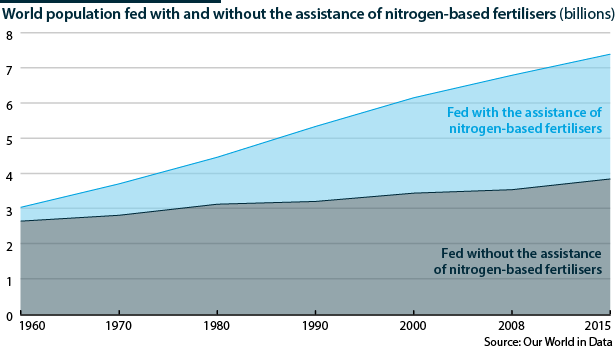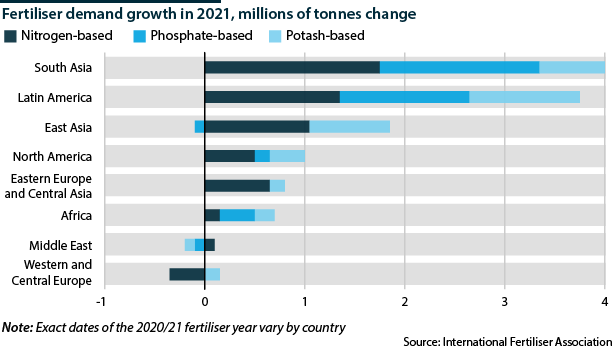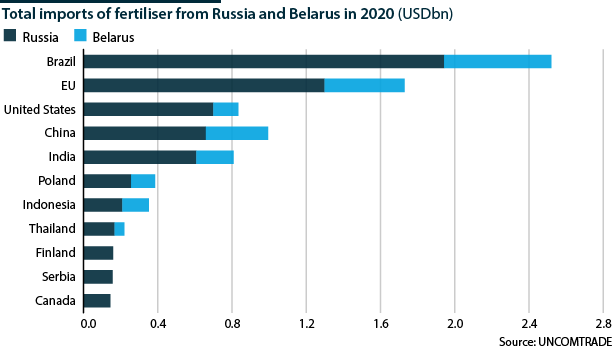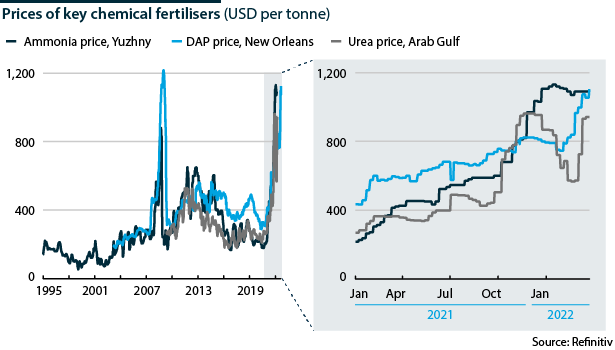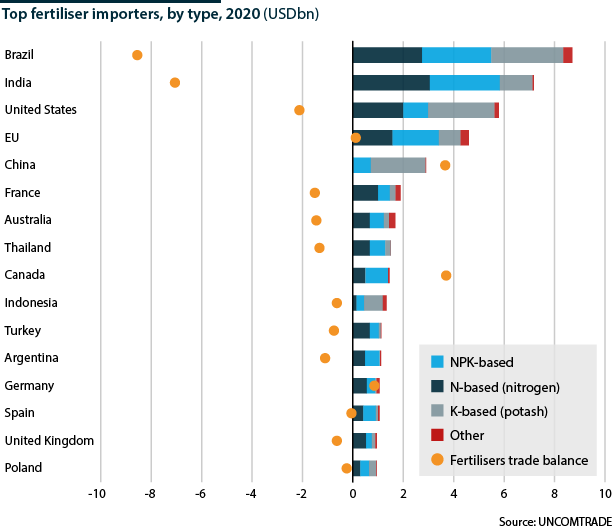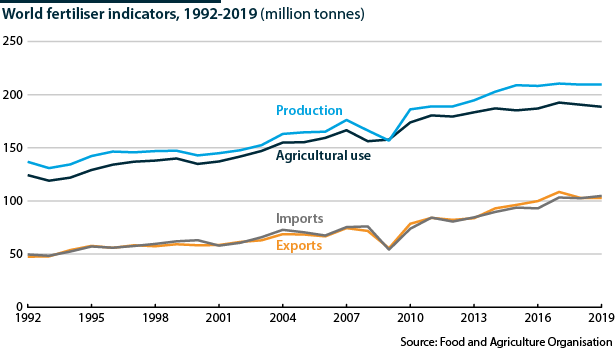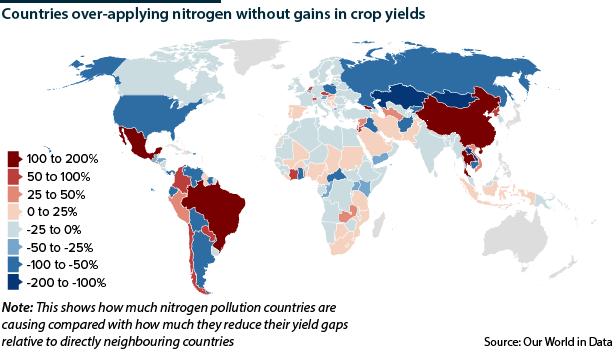Fertiliser and food prices could be high for years
High demand and many supply interruptions have pushed fertiliser prices to record levels and the disruption will persist
Russia and Belarus supply more than 20% of the world’s fertilisers, in a market that was extremely tight even before the Ukraine invasion last month. Fertiliser is crucial to agricultural output and global demand for it rose by 6.3% in 2021. This, combined with supply disruptions, took prices 78.6% higher year-on-year in 2021, according to the IMF. After the invasion, fertiliser prices soared to record highs. Tighter Western sanctions on Belarusian fertiliser producers last month have heightened the supply-side risks.
What next
The fertiliser market imbalance, like that in the semiconductor chip market, will last well beyond this year. Persistently higher fertiliser prices will reduce usage and thus lower crop yields into 2023. This will increase poverty and food insecurity, and dampen GDP growth and living standards. Supply will fall faster than demand for fertiliser in 2022/23, keeping prices high and prompting self-sufficiency drives and supply chain changes. This may increase intra-regional trade in fertiliser.
Subsidiary Impacts
- About 30% of the world's population lacked access to adequate food in 2020, the World Bank says, and the share could exceed that in 2022.
- Carbon dioxide produced as a by-product of fertiliser output is key to packaging fresh food; more CO2 shortages will disrupt food packing.
- Fertiliser output, consumption and trade patterns will change as countries seek more self-sufficiency, creating chances for new suppliers.
- Merger and acquisition activity will rise in the fertiliser market, likely raising market concentration and contributing to higher prices.
- Lower use of fertilisers will reduce emissions from their production and application, helping countries to meet climate targets.
Analysis
Fertiliser use has risen sharply since the 1960s, raising crop yields. In 1960, when chemical fertiliser use was much rarer, crop yields without fertiliser assistance supported 87% of the world population. By 2015, just 52% of the world population could have been fed from crops grown without chemical fertiliser assistance.
The three main types of chemical fertiliser are nitrogen-based (designated by chemical element symbol N), phosphate-based (P, for phosphorus) and potash-based (K, potassium). Diammonium phosphate (DAP) is the most commonly used P-based fertiliser.
Demand for N-based fertiliser rose by 5.0% to 113.7 million tonnes in the 2020/21 farming year. Demand for P-based supplies rose by 6.8% to 49.7 million while demand for K-based supplies rose by 9.1% to 40.4 million.
N-based fertiliser, which accounts for roughly 55% of consumption, increases plant growth and must be applied every year. P- and K-based fertiliser increase crop quality. The three nutrients are mostly used in combination.
Demand
Global demand for fertiliser rose by 6.3% in the 2020/21 growing season (usually July-June), according to the International Fertiliser Association (IFA), having grown by less than 2% each year from 2015/16 to 2019/20.
In the last few years, several factors have boosted demand:
- Governments have sought to develop domestic agriculture to boost self-sufficiency and reduce reliance on global supply chains. The major economies are all trying to move towards this, albeit to different degrees and by targeting different sub-sectors.
- The self-sufficiency drive became more marked after the pandemic-related disruption of global supply chains. Eighteen countries have introduced 49 trade restrictions on food and fertilisers since the start of the pandemic, according to the Global Trade Alert.
- The growth of food prices in 2021 (by 129.1%, according to the IMF) created an incentive for farmers to raise output, which they did by using more fertiliser to maximise yields.
- There is anecdotal evidence that farmers brought fertiliser purchases forward in 2021 to guard against delays and changes in prices and exchange rates.
The price of wheat has risen to record highs on global markets
Demand for fertiliser rose everywhere in 2021 except Western and Central Europe and the Middle East. In the case of the EU, its 'Farm to Fork' strategy aims to improve farming sustainability and specifically to reduce chemical-based fertiliser use by 20% by 2030 to help reduce carbon emissions. Both manufacture and use of chemical-based fertilisers create emissions.
Late last year the IFA responded to historically high prices by revising its forecast for fertiliser demand in 2021/22. It had forecast 2021/22 growth of 0.9% in August, but the price shock prompted it to downgrade this in November to a contraction of 2.7%, due largely to reduced affordability.
In its revised forecast, the IFA expects nitrogen-based fertiliser demand to fall by 2.1%, with falls of 3.3% and 3.8% for phosphate and potash fertilisers, respectively. Nitrogen-based fertiliser was expected to be least affected as it is the most used of the main chemical fertilisers for all main crops. It must be applied every year, unlike phosphate- and potash-based fertilisers. The IFA forecast that demand would rebound by 2.9% in 2022/23.
Supply
The high prices in late 2021 were partly a consequence of supply-side strains that had built up since 2020 (see MIDDLE EAST/NORTH AFRICA: Wheat supply challenges - March 28, 2022):
- COVID-19-related shutdowns disrupted output worldwide. Bad weather last year disrupted US output, especially in Texas, which is a key producer of the nitrogen-based fertiliser compound ammonia and suffered a severe storm in February 2021.
- The high costs of shipping freight and raw material inputs such as natural gas raised producers' costs. Energy feedstocks account for 70-80% of the cost of producing nitrogen-based ammonia as a fertiliser.
Belarus sanctions
Belarus accounted for around 20% of global potash-based (K) fertiliser exports in 2019 and 2020. In October 2020 Western states applied sanctions on Belarus.The potash sector was initially little affected, but over the last year year multiple sanctions have been applied to fertiliser:
- In August 2021, the US administration announced that Belarus's two state-owned potash fertiliser producers -- Belaruskali, the potash miner, and Belarusian Potash Company, the exporter, would be sanctioned. US sanctions were enforced on Belaruskali from December 8,and apply to the Belarusian Potash Company from April 2022 (see BELARUS: Lukashenka puts reckless faith in Russia - August 10, 2021 and see BELARUS: EU's oil products ban will hurt - July 2, 2021).
- On February 1, Lithuania banned Belarus from using its Klaipeda port. Previously this was the main port for Belarusian fertiliser exports. Finding new routes, largely through Russia, such as the Ust-Luga port, will raise costs and delivery times.
- Norway-based Yara, the world's largest fertiliser manufacturer, announced in January that it would phase out its imports of Belarusian potash. Belaruskali was Yara's largest potash supplier, and Yara bought 10-15% of its output.
- In early March, the EU stopped potash imports from Belarus.
Invasion effects
Fertiliser prices, already high coming into 2022, have soared since the Ukraine invasion (see RUSSIA/UKRAINE: War will disrupt global wheat trade - March 25, 2022).
Western sanctions do not directly apply to Russian fertiliser firms. Nonetheless, supplies will be disrupted as Western traders try to avoid Russian supplies and shippers worry about costs, safety and insurance on the Black Sea route.
Until now, Russia accounted for a double-digit global share of each of the N-, P-, K-based and NPK (mixture) fertiliser markets. It was the world's largest exporter of fertiliser, earning USD7bn annually, and the only one of the largest exporters to be self-sufficient in every fertiliser.
Russia's trade ministry recommended this month that producers temporarily halt fertiliser exports because of new risks associated with foreign logistical companies. Whether they comply or not, supply is likely to be disrupted due to economic dislocation affecting production and seaborne exports.
Other key exporters
China and Canada are the second- and third-largest fertiliser exporters and run trade surpluses. However, although China is a large net exporter of N- and NPK-based fertiliser, it is a large net importer of K-based fertiliser, especially from Belarus, exposing it to disruption and higher costs.
Canada accounted for 36% of K-based fertiliser exports in 2020 and is raising its potash output this year to be in a position to fill some of the market gaps. It imports NPK fertiliser and balances out in N-based fertiliser trade.
The United States is the fourth-largest fertiliser exporter, but runs a fertiliser trade deficit overall. It runs a surplus in NPK-based fertiliser but a deficit in N- and K- based fertiliser. It is likely to import more from Canada.
Key importers
Brazil and India are the largest net importers of fertiliser. Longer-term, farmers worldwide will look to produce more domestically or change suppliers but in the short term, they will consider using less fertiliser or planting less crops, thus reducing yields.
Smaller economies will suffer more than major economies. In South Africa, fertiliser makes up 35% of farmers' input costs and this share is likely higher in some other African countries.
November projections and further revisions
In its November revision, the IFA forecast supply of N-, P- and K-based fertilisers to be lower in 2021/22 due to supply disruptions:
- It expects production of ammonia and urea, the key N-based fertilisers, to fall by about 3% in 2021/22.
- P-based fertiliser production is expected to be 2% higher.
- K-based fertiliser output was expected to grow by more than 4.0%, driven by demand from the Americas and South-East Asia.
The Western ban on Belarusian fertilisers means that the K-based potash market faces disruption. Belarus previously exported around 12 million tonnes of potash fertiliser annually. Estimates in early February that up to 2 million tonnes would fail to reach the market will now be revised upwards.
Supply of all types will be lower than expected in November, and will fall more than demand.
Outlook
The fertiliser market has been stable over the past 30 years but the convergence of so many supply disruptions will disrupt it more, and for longer than the 2008-09 disruption did (see INT: High food and metals prices to outlast conflict - March 22, 2022).
Fertiliser production, trade and demand will be lower. Yara, the world's second-largest ammonia producer, announced in early March that its ammonia and urea production would operate at 45% capacity this year due to supply disruptions.
Responses
The United States, Canada, Brazil and Tunisia are among countries planning to produce more fertiliser domestically. The US Department of Agriculture this month announced a USD250mn plan to support production, with funds expected to be awarded to projects from the end of 2022. Canadian giant Nutrien plans to raise potash output by nearly 1 million tonnes this year.
Brazil announced a National Fertiliser Plan last month, aiming to reduce import dependency from 85% to 45% by 2050. It wants to raise its nitrogen production capacity to 2.8 million tonnes by 2050, and to attract USD10bn of private investment to facilitate this.
Late last year, and again last month, India increased the subsidisies it gives farmers to buy fertiliser. India gets most of its potash-based fertiliser imports from Russia and Belarus, and has not signed up to Western sanctions against either.
It will take years for Western countries to reorient their supply chains towards allies. Meanwhile, prices of fertiliser and food will be volatile and historically high. This will increase the number of people facing poverty and food insecurity.
Furthermore, the market has never been more vulnerable to further shocks -- especially a geopolitical shock involving China, the second-largest fertiliser exporter.
The fertiliser market has never been more vulnerable to further shocks, especially one involving China
Rationalisation options
It is not axiomatic that reduced consumption of fertiliser will result in lower agricultural yields; that would only be the case if fertiliser were used efficiently worldwide.
Research by David Wuepper et al in 2020 compared how much nitrogen pollution economies are causing from fertiliser use with how much they increase their yields relative to neighbouring countries. China and Brazil stand out as over-appliers.
In many lower-income regions, fertiliser demand is lower than would be ideal for crop yields, due to inaccessibility and unaffordability. The United Kingdom used 169 kilograms of fertiliser per hectare of cropland in 2017 whereas China used 220 kilograms. In contrast, Nigeria used 11 kilograms per hectare and Bolivia 3.2 kilograms.
The fertiliser supply squeeze is likely to retard global development convergence, in common with other developments during the pandemic.
The gap between the fertiliser use and needs of high- and low-income economies makes it impossible for multinational organisations and NGOs to recommend universal solutions. At the same time, these organisations are key to ensuring that as many farms as possible have access to the advice and ideally the funds they need to use fertiliser more efficiently.
Sustainable farm management practices such as crop rotation are key. New technologies including drones and satellite imagery can help farmers know which parts of their farms need more or less fertiliser. Plant-breeding technologies capable of changing a crop's genetic make-up to aid fertiliser absorption could also grow in use.
Estimates see the agritech market doubling from less than USD17.5bn in 2019 to more than USD40bn in 2027. Private equity investment in agritech start ups has grown by more than 50% per year for the last four years. However, it will take years to roll these technologies out widely, and especially to lower-income countries.
There will be an environmental upside to lower production and consumption of fertilisers. Ammonia is made at high temperatures and accounts for 1-2% of global greenhouse gas emissions, according to the Climate Portal run by the Massachusetts Institute of Technology. Moreover, fertilisers produce emissions after application as crops only absorb around half the amount applied. The rest can damage the soil or run into waterways, disrupting biodiversity.
Growing shortages of fertiliser and food will have lasting ramifications for the global economy (see INT: High food prices may spark social unrest - March 8, 2022). WTO Director-General Ngozi Okonjo-Iweala said this month that "my worry is that we have a food crisis that is brewing". Fertiliser, which is key to food output, will be central to this.
